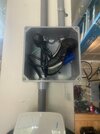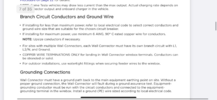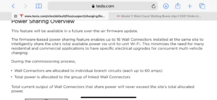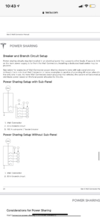I'm not an electrician and I did not do this install myself. We paid for the install and I want to verify information. If we have two gen 3 wall connectors being fed from a single 60a breaker? Is it not true that both the connectors need to have their own 60a breaker at the point where they split from the main feed? We have had this electrician do multiple projects for us and I don't want to second guess his work. But considering we are talking over $2000 for chargers and $130k in cars, I am being a bigger pain in the ass.
Welcome to Tesla Motors Club
Discuss Tesla's Model S, Model 3, Model X, Model Y, Cybertruck, Roadster and More.
Register
Install the app
How to install the app on iOS
You can install our site as a web app on your iOS device by utilizing the Add to Home Screen feature in Safari. Please see this thread for more details on this.
Note: This feature may not be available in some browsers.
-
Want to remove ads? Register an account and login to see fewer ads, and become a Supporting Member to remove almost all ads.
You are using an out of date browser. It may not display this or other websites correctly.
You should upgrade or use an alternative browser.
You should upgrade or use an alternative browser.
Any electricians here?
- Thread starter a1machinista1
- Start date
Acps110
Member
As long as you have the latest software on the Wall Connectors, make sure that load sharing is setup for both. They will then share the 60A circuit intelligently to charge one or both cars without overloading the circuit.
ucmndd
Well-Known Member
That might be Kosher IF each wall connector is independently configured to provide a max of 24 amps, which would be stupid.
But generally no, that’s not how you do it and if they can each try to draw 48 amps you’ll obviously have a problem.
See the “power sharing” section of the install manual for the right way, which wants them each on their own circuit
I suppose it would work this way if the total site power was limited to 48 amps in the sharing config.
But generally no, that’s not how you do it and if they can each try to draw 48 amps you’ll obviously have a problem.
See the “power sharing” section of the install manual for the right way, which wants them each on their own circuit
I suppose it would work this way if the total site power was limited to 48 amps in the sharing config.
This was my concern. So this means that when I set up the load sharing I would have to set each connector to a max of 24a? If that is true? Then I lose the capability to charge one car at 48a? Correct?That might be Kosher IF each wall connector is independently configured to provide a max of 24 amps, which would be stupid.
But generally no, that’s not how you do it and if they can each try to draw 48 amps you’ll obviously have a problem.
See the “power sharing” section of the install manual for the right way, which wants them each on their own circuit
I suppose it would work this way if the total site power was limited to 48 amps in the sharing config.
Acps110
Member
No, Load sharing will charge 1 car at 48A regardless of which Wall Connector it is plugged into, or both cars at 24A.This was my concern. So this means that when I set up the load sharing I would have to set each connector to a max of 24a? If that is true? Then I lose the capability to charge one car at 48a? Correct?
If I set each connector to 48a and then plug in both cars? I would guess that the sharing feature would only let each one have half of the available feed? Or would it? Being this is still very new technology I just want to be sure. I did send the online installation manual to him a few weeks ago so he could review it if this set up was new to him. Here is what I have after taking the cover off the (sub panel)
Attachments
beatle
Active Member
I thought that was how it was supposed to work anyway - you daisy chain two HPWCs to the same circuit and they intelligently determine whether they can pull max current or if they have to share based on load.I suppose it would work this way if the total site power was limited to 48 amps in the sharing config.
That said, the NEC says that each outlet for EV charging must be on its own branch circuit:
210.17 Electric Vehicle Branch Circuit.
Outlet(s) installed for the purpose of charging electric vehicles shall be supplied by a separate branch circuit. This circuit shall have no other outlets.
www.electricallicenserenewal.com
Tesla's power sharing says the same thing:
Sounds like the real benefit to power sharing is not to overload your entire house or if you're charging multiple Teslas at once, but I've read and seen instances where two HPWCs are connected to the same circuit.During the commissioning process, • Wall Connectors are allocated to individual branch circuits (each up to 60 amps)
Acps110
Member
With load sharing you set 1 Wall Connector to 60 A breaker / 48 A charging and as the leader, then you set the other Wall Connector as a follower.If I set each connector to 48a and then plug in both cars? I would guess that the sharing feature would only let each one have half of the available feed? Or would it? Being this is still very new technology I just want to be sure. I did send the online installation manual to him a few weeks ago so he could review it if this set up was new to him. Here is what I have after taking the cover off the (sub panel)
Gen 3 Wall Connector Power Sharing
We will have two Tesla's plugged in every night. Both will be high mileage drivers.I thought that was how it was supposed to work anyway - you daisy chain two HPWCs to the same circuit and they intelligently determine whether they can pull max current or if they have to share based on load.
That said, the NEC says that each outlet for EV charging must be on its own branch circuit:
210.17 Electric Vehicle Branch Circuit.
Outlet(s) installed for the purpose of charging electric vehicles shall be supplied by a separate branch circuit. This circuit shall have no other outlets.www.electricallicenserenewal.com
Tesla's power sharing says the same thing:
Sounds like the real benefit to power sharing is not to overload your entire house or if you're charging multiple Teslas at once, but I've read and seen instances where two HPWCs are connected to the same circuit.
Ok this is helping me understand. Now I just have to figure out the process.With load sharing you set 1 Wall Connector to 60 A breaker / 48 A charging and as the leader, then you set the other Wall Connector as a follower.
Gen 3 Wall Connector Power Sharing
ucmndd
Well-Known Member
Are you happy with charging each car at only 24A? Is that enough juice? Is that what you thought you were paying for? Do you have a main feed or panel limitation that makes a higher output impossible?We will have two Tesla's plugged in every night. Both will be high mileage drivers.
Try charging both cars and see what happens. Worst case while you’re sitting there watching it you’ll just trip the breaker.
Last edited:
How long are they going to be plugged in for (how much charging time is available). Do you care about time of use? How many miles do you drive?We will have two Tesla's plugged in every night. Both will be high mileage drivers.
If we assume a somewhat conservative 3 miles per wall kWh (including some charging losses), 10 hours available for charging, at 240 Volts and 48A you will be able to push 345 miles back into the cars.
I was unaware that Tesla had implemented load sharing, and my Wall Connector Model 3 has not yet been update to the required 21.18.1 version. You must have this version, or higher, installed on the Wall Connector doing load sharing. If the wall connectors are install according to the instructions in the small installation manual, it should handle up to 4 Wall Connectors. Check your version. Read the simple configuration instructions and check to see that it was installed correctly and is on the correct version. You will need to use the "Commissioning Instructions" in the manual to check the version of the wall connectors. You can download the upgrade file from Tesla at the link previously provided. I doubt the Wall Connector is shipped with this software version, since mine has not been updated yet by Tesla. Gen 3 Wall Connector Power Sharing
I assumed going into this that I would only have 24a for each car every night. I was assuming also that I would have 48a when only one car was plugged in. We are maxed at 60a for supply. The while reason we did this is to avoid having to switch the charger over every night. I don't have either car yet. Y should be Aug 25th according to SAAre you happy with charging each car at only 24A? Is that enough juice? Is that what you thought you were paying for? Do you have a main feed or panel limitation that makes a higher output impossible?
Try charging both cars and see what happens. Worst case while you’re sitting there watching it you’ll just trip the breaker.
Model S with definitely be here in October.
Model S will be driven 30k per year, about 150 miles a day year round.How long are they going to be plugged in for (how much charging time is available). Do you care about time of use? How many miles do you drive?
If we assume a somewhat conservative 3 miles per wall kWh (including some charging losses), 10 hours available for charging, at 240 Volts and 48A you will be able to push 345 miles back into the cars.
Model Y will be 15k a year
Not worried about time of use
12+ hrs a night available to charge
ucmndd
Well-Known Member
In that case it sounds like you got what you wanted and what you paid for. Assuming the load sharing is set up correctly you should be good to go.I assumed going into this that I would only have 24a for each car every night. I was assuming also that I would have 48a when only one car was plugged in. We are maxed at 60a for supply. The while reason we did this is to avoid having to switch the charger over every night. I don't have either car yet. Y should be Aug 25th according to SA.
Model S with definitely be here in October.
I was having issues on my iPhone getting an update to download. Eventually figured out it didn't like the browser. I used duck duck go and it worked. I was looking through the install guide to see if I could educate myself further before I call the electrician tomorrow. The way I read it ( (not being an electrician) is confusing.I was unaware that Tesla had implemented load sharing, and my Wall Connector Model 3 has not yet been update to the required 21.18.1 version. You must have this version, or higher, installed on the Wall Connector doing load sharing. If the wall connectors are install according to the instructions in the small installation manual, it should handle up to 4 Wall Connectors. Check your version. Read the simple configuration instructions and check to see that it was installed correctly and is on the correct version. You will need to use the "Commissioning Instructions" in the manual to check the version of the wall connectors. You can download the upgrade file from Tesla at the link previously provided. I doubt the Wall Connector is shipped with this software version, since mine has not been updated yet by Tesla. Gen 3 Wall Connector Power Sharing
It says that on sites that have multiple connectors, each connector must have its own branch circuit with L1/L2/N and ground. BUT it also shows a schematic showing 4 connectors on the same circuit? I'm sure it is something I'm not understanding...
Attachments
You should have no trouble filling each car overnight even with the worst case of the numbers you gave. 150 miles per day is about 55K miles per year. If we assume the Y is at 75 miles per (15K per year is 42 miles/day) that only adds up to 225 miles per day.Model S will be driven 30k per year, about 150 miles a day year round.
Model Y will be 15k a year
Not worried about time of use
12+ hrs a night available to charge
I think your electrician did not install things correctly. Two 60 amp branch circuits are needed: One routed to each HPWC. That is what the diagrams indicate is required. The sub panel shown would need to have a 100A breaker upstream.
Tesla has now implemented load sharing on the Wall Connector 3. Wall connectors can now intelligently share a single circuit, up to 4 wall connectors. Gen 3 Wall Connector Power SharingI think your electrician did not install things correctly. Two 60 amp branch circuits are needed: One routed to each HPWC. That is what the diagrams indicate is required. The sub panel shown would need to have a 100A breaker upstream.
Similar threads
- Replies
- 1
- Views
- 217
- Replies
- 4
- Views
- 146
- Replies
- 5
- Views
- 562






